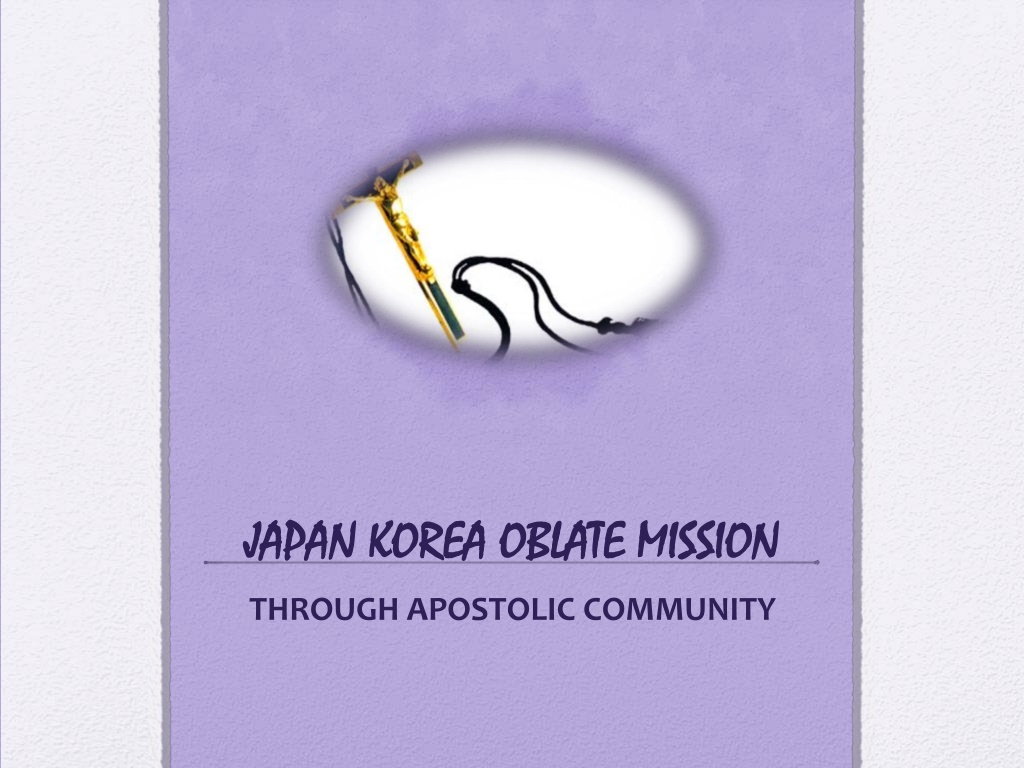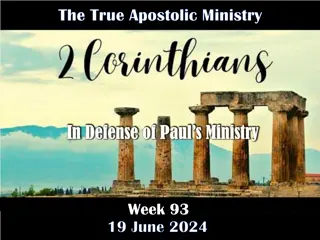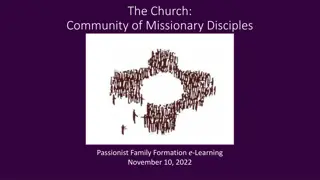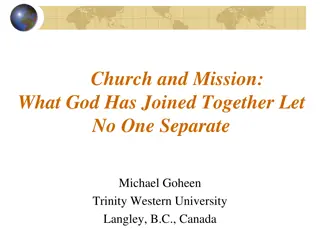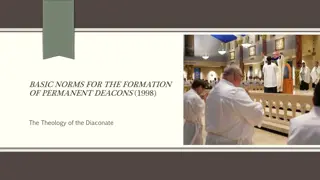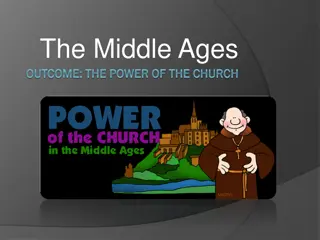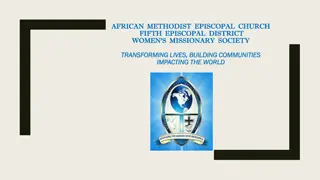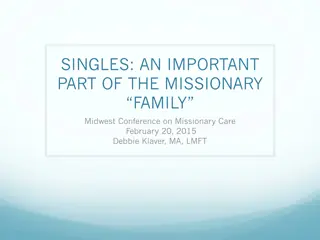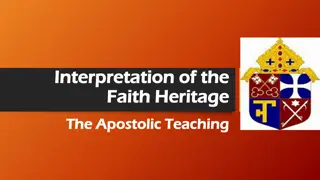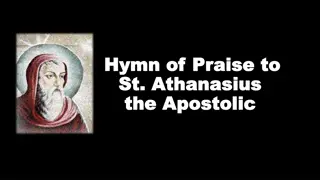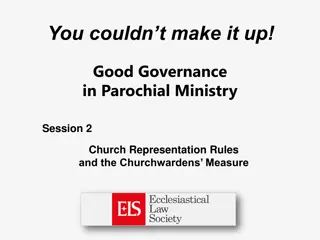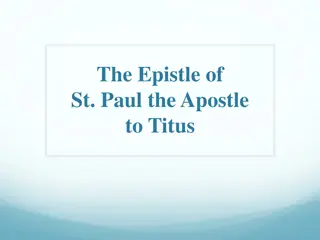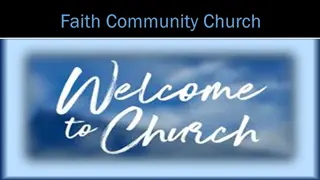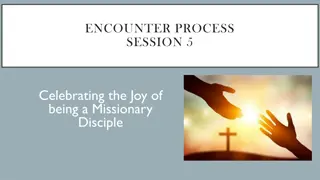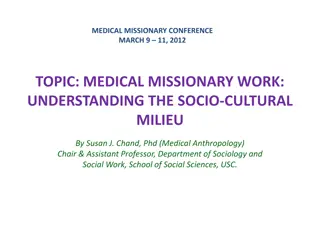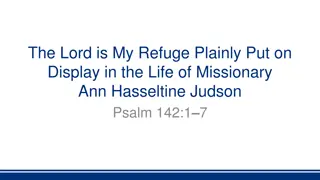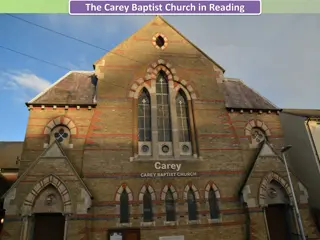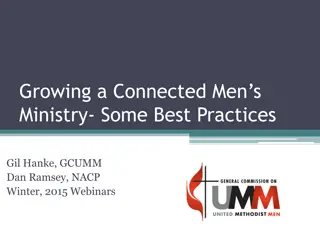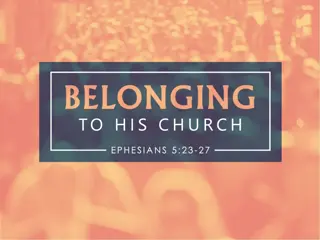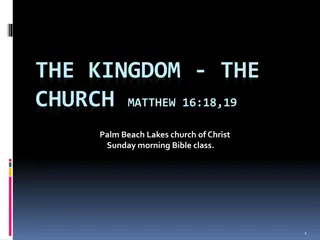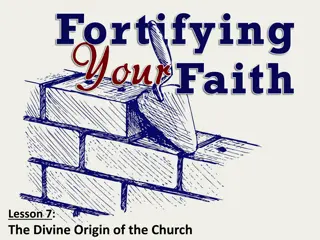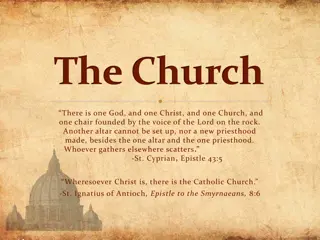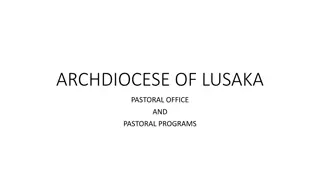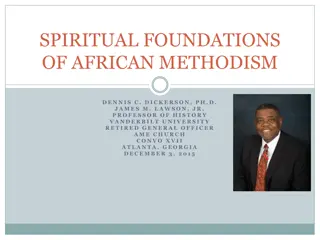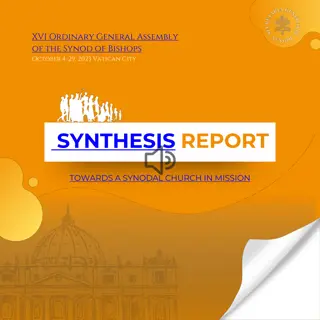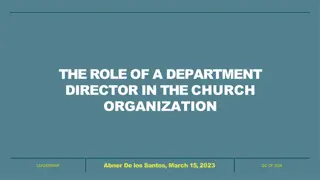The Missionary Community in the Early Church: Apostolic Foundation
Illustrating the foundation and essence of the early Christian missionary community, the Acts of the Apostles serves as a blueprint for unity, mission, and community building based on the model of Jesus and his Apostles. Embracing the call of Jesus Christ, the Oblates strive to embody the apostolic spirit through shared mission and community, reflecting the unity and purpose exemplified by the early Church.
Download Presentation

Please find below an Image/Link to download the presentation.
The content on the website is provided AS IS for your information and personal use only. It may not be sold, licensed, or shared on other websites without obtaining consent from the author. Download presentation by click this link. If you encounter any issues during the download, it is possible that the publisher has removed the file from their server.
E N D
Presentation Transcript
JAPAN KOREA OBLATE MISSION JAPAN KOREA OBLATE MISSION THROUGH APOSTOLIC COMMUNITY
COMMUNITY AND MISSION ECCLESIAL (BIBLICAL) DIMENSION the call of Jesus Christ that brings the Oblates together and invites them ... to share in his mission (C.l) and community of the Apostles with Jesus is the model of our life . (C.3) The call and the presence of the Lord among us today bind us together in charity and obedience to create anew in our own lives the Apostles unity with him their common mission in his Spirit (C.3).
APOSTOLIC COMMUNITY Thus, for the basis and ultimate source of meaning of our community, life and mission, we are referred to the experience of Jesus and his Apostles.
The Missionary Community in the Early Church New Testament writings give a clear picture of the early community in relation to the mission. the Acts of the Apostles, which is both the book of the mission and the book of the formation of the first Christian community, means to say, the foundation of the Church.
The Missionary Community in the Early Church the Apostles, after Jesus resurrection and ascension, took up the responsibility from their Master (Jesus) to continue His mission with the Spirit of Pentecost which they received, the Spirit provoked them:
The Missionary Community in the Early Church to go away from their familiar shows, to go afield give witness to the Gospel before all men and women, to go out on mission; the same Spirit impelled them to be together, to live out some powerful reality amongst themselves, to be a community, to be Church.
The Missionary Community in the Early Church three brief summaries which give a picture of the life of the first Christian community: The apostles teach (2:42-47); united one heart and one soul (4: 32-35); many added to their rank (5:12-16) There are four essential values Acts of the Apostles articulates: elements that made it a living and influential community. of this community,
The Missionary Community in the Early Church They devoted themselves to Apostles : Instructions (Teaching) Communal Life (KOINONIA - the fraternal communion ) The Breaking of Bread The Prayers (Acts 2:42).
The Missionary Community in the Early Church They devoted themselves, regularly, together nourishing their faith commitment. This dedication of the apostles became a model of community missionary life which we are invited to find in these texts as an inspiration for building dynamic communities which can give witness through the very quality of our community living.
The teaching of the Apostles, the prayers and the breaking of the bread The apostles were teaching the first Christians in two fronts one at the same time: To non-Christians: proclaiming the KERIGMA ( Word ), the essential contents of the Good News of Jesus Christ, which prepared them for conversion and brought them to baptism. To nourished DIDACHE ( catechesis ). the Christian by community: apostles constantly teaching the
So Christians of the early Church devoted themselves to the instruction of the Apostles .
The teaching of the Apostles, the prayers and the breaking of the bread Luke also is reminding us that a community of believers - an apostolic community - must nourish itself constantly with the reading and meditation of the gospels; otherwise, it will stop growing, weaken and die, both as community and as a missionary unit. (First requisite)
The teaching of the Apostles, the prayers and the breaking of the bread So the first requisite of the Christian missionary life: A person cannot be a witness of Jesus Christ unless he deepens his relationship with Him, and this in turn supposes that a person is motivated by the ardent desire to know Jesus better, as He really is, and to be His disciple and witness. It is listening to the Gospel which will first of all teach us who Jesus is and what He expects of those who have committed their lives to following Him.
The teaching of the Apostles, the prayers and the breaking of the bread What were the other practical requisites for living community and mission in the life of the early Christians? Apart from listening to the gospel, we recognize the importance of the two other requisites at the basis of a missionary community, that is, prayer. Indeed, no one can affirm that he believes in Jesus as a living Person if one does not approach him in a personal relationship of prayer, and also if one does not celebrate his life-giving presence in the Eucharist.
The teaching of the Apostles, the prayers and the breaking of the bread The content of Apostles prayer to God: is taken from passages of psalms that were chosen in line with what the community has just been living. The early community, teaches us to base our prayer on life, especially on the difficulties and joys of our missionary life, by drawing from the Scriptures the inspiration which sheds light on our experience, sustains it and celebrates it in God s presence. They pray as a community very especially in the important moments of its life and mission.
The teaching of the Apostles, the prayers and the breaking of the bread They gathered to pray in times of persecution and trial: for example, when Peter was in prison, right after the killing of the Apostle James (12:5, 12), or again when Paul says farewell to the church at Ephesus after he had mentioned the chains and hardships that were awaiting him (20:23, 36-38). The community does not entrust any new responsibilities or open a new missionary field without taking the time to pray beforehand. Thus there is no mission that does not begin with prior prayer. Prayer is the great moments of its mission.
The teaching of the Apostles, the prayers and the breaking of the bread mission necessarily requires strong moments of personal and community prayer. The community prayer found its peak in the Eucharistic celebration which, as we know, was originally referred to as the breaking of the bread . Community meals taken in private houses (Acts 2:46; 20, 7ff) became Eucharistic meals.
The teaching of the Apostles, the prayers and the breaking of the bread The first community persistently gathered for the Eucharistic meal (2:42). significance of the Eucharist, Paul uses the Greek word KOINONIA (communion) (1 Co 10:16-17). To describe the In other words Eucharist and communion go hand- in-hand. Paul shows his community at Corinth, which had become divided, that the Eucharist loses its meaning if there is no true fraternal sharing in the community (1 Co 11:17-22)
The Eucharist both expresses and nourishes: KOINONIA, that is to say, the fraternal communion.
The fraternal communion Likewise, we read again in 4:32: The community of believers (= union with Christ) were of one heart and one mind (=union with each other and amongst themselves). None of them ever claimed anything as his own; rather, everything was held in common (= sharing of everything).
The fraternal communion KOINONIA - fraternal communion : a very strong union among the Christians, which has its source in each one s union with and in Christ, and leads to a sharing in all things, spiritual and material. The Christian community is therefore not merely a good human fraternity. It is first of all a reality of the spiritual order.
The fraternal communion However, KOINONIA is real only if it translates itself into all the dimensions of human life, that is to say, there exists in the community a true sharing of all the realities of life.
The fraternal communion Community life aims: to give its members; the needed resources and support so that they can go and give witness elsewhere. Even evangelizing by its very reality as community, by the quality of life as community. Depending on its way of life, the community is either a witness or a counter-witness. prior to this, the community is
Depending on its way of life, the community is either a witness or a counter-witness. First we evangelize by what we are - personally and collectively, rather than by what we say and do.
Community and material sharing We still need to discern, personally and in community, what is distinguish false from real needs. Material sharing was practised not only within the communities but also between communities, as the event narrated in Acts 11:17-30 shows. superfluous and to
Community and material sharing The community of Antioch was sending aid to the communities of Judea who were victims of a famine, according to his means (11:29). The principle for the use of goods invites the communities to share what is superfluous with those who are deprived anywhere on this earth, no matter what their beliefs.
The communitys influence (witness) and attraction Nourished by the four values or commitments: Teaching, communion, breaking of bread together (and material sharing) and prayer, the first communities exercised a strong power of influence, attractionand witness. There communities. Such is the conclusion that we find at the end of community life: was a real desire to join such the description of
The communitys influence (witness) and attraction There was a real desire to join such communities. They won the approval of allthe people . Day by day the Lord added to their number those who were being saved (2:47); ...the people held them in great esteem. Simplicity and joy of community living are the signs of the risen Lord s presence within the community.
The communitys influence (witness) and attraction The Apostles were witnessing to the Lord s resurrection not only through word but also by the quality of their community life. Your light must shine before men, so that they may see goodness in your acts and give praise to your heavenly Father (Mt 5:16). Thus, personally and collectively, rather than by what we say and do. we evangelize by what we are,
Conclusion The relationship between community and mission can be established also from the opposite direction. In order to form a living community, one has mobilized for the mission. to be completely
Conclusion The community is formed and grows through its evangelization commitment. Community and mission are two inter-related realities: they call for each other and mutually make each other fruitful in a constant interrelationship.
Conclusion The most profound expression of the bond that exists between community and mission is found in the gospel of St. John. In His priestly prayer - a prayer which we could also qualify as missionary Jesus entrusts to his disciples the mission of being the sign and reflection of the communion that exists between the Father and the Son by means of their communion amongst themselves
Conclusion and to be the sign and reflection of God s love for all through their love for one another: ...that all may be one as you, Father, are in me and I in you; ...that they may be one in us, that the world may believe that you sent me... that they may be one as we are one, I living in them, you living in me, that their unity may be complete.
Conclusion So shall the world know that you sent me and that you loved them as you loved me (Jn 17:21- 23; cf. v .ll). After this, he had given to his disciples his new commandment, Jesus adds: This is how all will know you for my disciples: your love for one another (Jn 13:35).
Conclusion To live and witness to God s KOINONIA, through the KOINONIA ourselves: such is the ultimate goal both of the mission and of the community! amongst
Arigato Gozaimasu Thank you.
